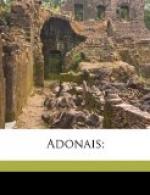1. 5, &c. ’How they fled When, like Apollo,’ &c. The allusion is to perfectly well-known incidents in the opening poetic career of Lord Byron. His lordship, in earliest youth, published a very insignificant volume of verse named Hours of Idleness. The Edinburgh Review—rightly in substance, but with some superfluous harshness of tone—pronounced this volume to be poor stuff. Byron retaliated by producing his satire entitled English Bards and Scotch Reviewers. With this book he scored a success. His next publication was the generally and enthusiastically admired commencement of Childe Harold, 1812; after which date the critics justly acclaimed him as a poet—although in course of time they grew lavishly severe upon him from the point of view of morals and religion. I reproduce from the Pisan edition the punctuation—’When like Apollo, from his golden bow’; but I think the exact sense would be better brought out if we read—’When, like Apollo from his golden bow, The Pythian,’ &c.
11. 7, 8. ’The Pythian of the age one arrow sped, And smiled.’ Byron is here assimilated to Apollo Pythius—Apollo the Python-slayer. The statue named Apollo Belvedere is regarded as representing the god at the moment after he has discharged his arrow at the python (serpent), his countenance irradiated with a half-smile of divine scorn and triumph. The terms employed by Shelley seem to glance more particularly at that celebrated statue: this was the more appropriate as Byron had devoted to the same figure two famous stanzas in the 4th canto of Childe Harold—
’Or view the Lord of the unerring bow,
The God of life and poesy and light,’ &c.
1. 9. ’They fawn on the proud feet that spurn them lying low.’ In the Pisan edition we read ‘that spurn them as they go.’ No doubt the change (introduced as in other instances named on pp. 105 and 113) must be Shelley’s own. The picture presented to the mind is more consistent, according to the altered reading. The critics, as we are told in this stanza, had at first ‘fled’ from Byron’s arrow; afterwards they ’fawned on his proud feet.’ In order to do this, they must have paused in their flight, and returned; and, in the act of fawning on Byron’s feet, they must have crouched down, or were ‘lying low.’ (Mr. Forman, in his edition of Shelley, pointed this out.) With the words ‘as they go’ the image was not self-consistent: for the critics could not be ‘going,’ or walking away, at the same time when they were fawning on the poet’s feet. This last remark assumes that the words ‘as they go’ mean ’as the critics go ’: but perhaps (and indeed I think this is more than probable) the real meaning was ’as the feet of Byron go’—as Byron proceeds disdainfully on his way. If this was Shelley’s original meaning, he probably observed after a while that the words ’as they go’ seem to follow on with ‘they fawn,’ and not with ‘the proud feet’; and, in order to remove the ambiguity, he substituted the expression ‘lying low.’




